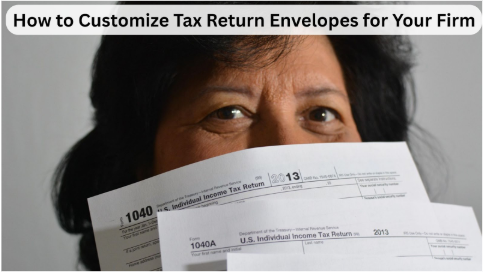
One thing you shouldn’t have to worry about during the tax season is how you present your clients with their documents. A plain envelope works, but a custom one brings order and professionalism to the process.
Custom tax return envelopes are more than just about looking good—they are a tool of uniformity and trust. They are an opportunity to communicate the name of your firm, give clear direction, and protect documents that no one should see.
If you’ve ever had clients who lost important paperwork or if you want to hand out returns in a way that demonstrates your careful consideration, custom return envelopes can lend a professional edge. This is how to approach them one by one.
1. Start with the Right Type of Envelope
The first step is choosing the right style of tax return envelopes for your needs. There are a few options for formats, including double-window, single-window, and plain. Double-window designs allow you to show both your company’s address and the client’s, which simplifies your mailing.
For basic use, single-window versions keep it simple while still looking professional. And plain envelopes are better when you’re in control of the design and the positioning of the text.
Consider what you’ll use most often. If you’re sending out larger packets, 9×12 envelopes are much better than smaller ones. If security is a concern, use an envelope with a tinted inside or use labels that will cover your client’s sensitive information fully.
You may also want to consider expandable envelopes if your returns tend to be bulkier. Starting with a good base will ensure both form and function.
2. Add Your Firm’s Information Clearly
After you’ve selected the type, the next step is ensuring that your firm’s information is printed on the envelope for easy readability. At a minimum, this is your company name, address, and phone number. Some companies even add their logo to create a branding opportunity.
The positioning of this information is important. For instance, a pre-printed return address in the upper left corner is a time-saver when sending multiple packets. It all looks cohesive when your colors and fonts are consistent with your other materials.
You also have more options for where you would like your branding to be if you are using plain envelopes. Windowed envelopes need less customization, but you can still place a logo and tagline for professional polish.
Clients maintain tax records for years. By printing your information directly on the envelope, you make it easy for them to find you again without digging through old files.
3. Prioritize Privacy and Security
Taxpayers have the right to confidentiality, and tax forms are filled with sensitive information. That’s why your envelopes should indicate how seriously you regard that trust. Customization isn’t just about aesthetics—it’s about showing your clients you value their confidentiality.
Look for designer tax return envelopes with security tints that obscure text inside. Self-sealing closures are another important feature that reduces tampering risks. Larger flap styles also provide extra coverage while giving the envelope a neat finish.
If you’re delivering packets by hand, go for thicker envelopes that won’t wrinkle in transit. For mail, make sure your design doesn’t interfere with postal codes or barcodes. Balancing security with practicality ensures that returns are both safe and professional-looking.
4. Design for Clarity and Function
Your design doesn’t have to be complicated. The objective is to keep the envelopes practical while reinforcing your firm’s identity. Simple details like adding your brand colors or a tagline below your logo make them instantly recognizable.
Think about usability, too. Envelopes with checkboxes or labeled sections, such as “Client Copy” or “File Copy,” help clients stay organized. You might also include bold instructions on the back flap, like reminders to store the documents securely.
Since your envelopes are often the first thing clients see before opening their returns, thoughtful design sends a strong message that you care about the little details.
5. Include Clear Mailing Instructions
One simple, but potentially valuable customization is to include mailing instructions right on the envelope. For those firms that have multiple clients at their offices at any given time, this can help reduce any confusion and improve delivery times.
This can be as simple as having something printed like “Tax Documents Enclosed,” “Do Not Bend,” or even “Confidential.” These quick notes will let both the postal service and your clients know how you want the envelope handled.
Some companies put color-coded stickers or those with printed words to identify one type of document from the others. This is effective, especially if your office releases return envelopes for personal and business tax returns. Be upfront about it so your clients won’t have to guess.
6. Plan Ahead for Bulk Ordering
Customization works best when planned. Ordering in bulk not only saves costs but also ensures consistency throughout tax season. Using the same design for all returns keeps the process smooth and avoids running out at the worst time.
When finalizing your design, consider how it will look across different envelope sizes. You may need both standard mailing envelopes and larger 9×12 ones for complete return packets. Maintaining a consistent design across all ensures a unified brand presence.
Bulk orders also help you avoid delays. The last thing you want in peak season is scrambling for mismatched envelopes. With a steady supply ready, you’ll stay efficient and organized.
Final Thoughts
Personalized tax return envelopes give your practice more than a polished look. They keep you organized, protect client privacy, and enhance professionalism. By starting with the right type, printing your details, and designing with security and clarity in mind, you set the stage for better client communication.
In the end, these envelopes may seem small, but they make a lasting impression. They safeguard necessary paperwork, keep it easily identifiable, and demonstrate that you take the same pride in presentation as you do in preparing accurate returns.